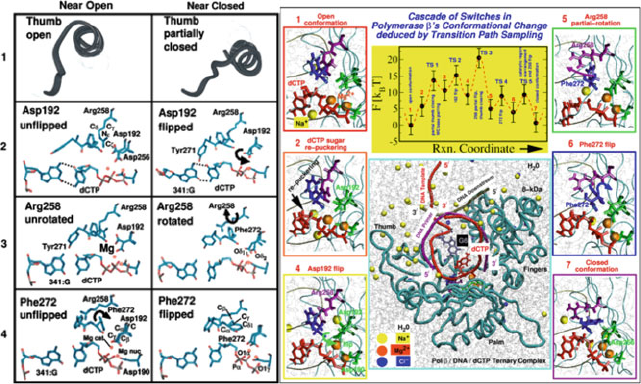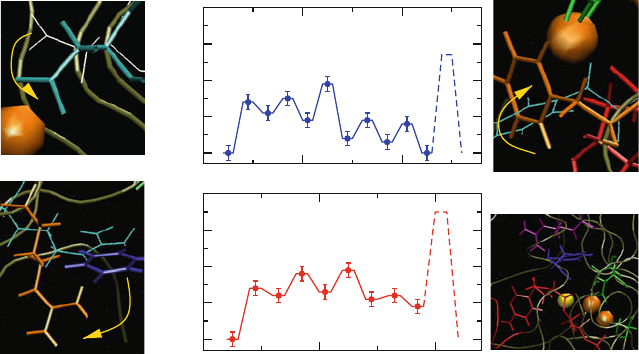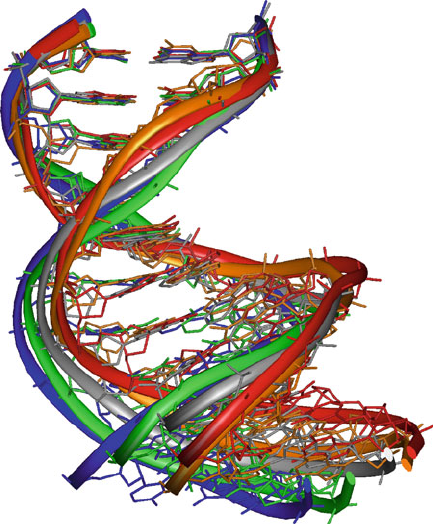Schlick T. Molecular Modeling and Simulation: An Interdisciplinary Guide
Подождите немного. Документ загружается.


512 14. Molecular Dynamics: Further Topics
Figure 14.18. Left: Molecular snapshots near open (left column) and closed (right
column) states of pol β for four transition state regions [1031]: (1) Partial thumb closing.
(2) Asp-192 flip. (3) Arg-258 partial rotation. (4) Phe-272 flip. Right: Overall captured
reaction kinetics profile (from TPS) for the conformational transition of pol β (for G:C)
from open (state 1) to closed (state 7) forms showing free energies (in k
B
T ) associated
with the different transition state regions. The meta-stable basins (in red) along the reaction
coordinate are numbered 1–7.
is used to find kinetic “bottleneck regions” by estimating rate constants associated
with reaching subsequent interfaces. Then, FFS concentrates on sampling those
bottlenecks regions only. FFS is appropriate for discretely defined surfaces, like
protein folding on a lattice [23].
Milestoning [354] coarse grains temporal and spatial descriptors of the system
by sequential transitions and then recovers reaction kinetics by integral equations
and global path optimization strategies. Similarly, Markov State Models (MSM)
[919] compute reaction rates from different interfaces by using transition net-
works to describe biomolecular kinetics and thermodynamics. See also [920].
Combinations of MSM with the single-sweep method [828] can be successful
for proteins [957] because phase space is surveyed to map dynamically important
regions, from which free simulations are initiated, and then the transition ma-
trix is constructed by piecing the information together. Clustering techniques for
partitioning space to locate key regions can also be used in this connection [1357].
Milestoning was compared to MSM, FFS, and transition interface sampling in
[1298], where the advantages of milestoning compared to the other methods were
suggested in terms of accuracy, efficiency, and parallel-machine implementations.
Various combinations of these methods, such as REMD with TIS (transition
interface sampling) to compute free energy profiles and rate constants when the
barriers are high [146], emphasize how different sampling approaches can be
combined in clever ways to suit the problem. Often, coarse-grained models are

14.8. Future Outlook 513
Free Energy (k
B
T)
0
10
20
30
40
0
10
20
30
40
Thumb
closing
Thumb
closing
rotation
258
ion
rearrange
ment
Product
192 flip
272 flip
272 flip
Chemical Reaction
Open
1
3
4
5
7
Closed
8
TS 1
TS 2
TS 3
TS 4
G:C
G:A
192 flip
258 rotation
272 flip
Closed
TS 1
3
4
192 flip
TS 2
258 Rotation
TS 3
5
TS 4
6
TS 5
7
Closed
Chemical Reaction
8
Product
Open
1
Figure 14.19. Overall captured reaction kinetics profile for pol β’s closing transition fol-
lowed by chemical incorporation of dNTP for G:C and G:A systems [1032]. The barriers
to chemistry (dashed peaks) are derived from experimentally measured kpol values. The
profiles were constructed by employing reaction coordinate characterizing order parame-
ters in conjunction with transition path sampling. The potential of mean force along each
reaction coordinate is computed for each conformational event.
used in combination with implicit solvation and Langevin or Brownian dynamics
or MC for added benefits. Still, applications of these methods to biomolecular
complexes at large remain a challenge.
14.8 Future Outlook
14.8.1 Integration Ingenuity
Many Approaches
In this chapter we have discussed various numerical integration techniques for
Newtonian and Langevin/Brownian dynamics and focused on variations that can
increase the timestep and lead to overall computational gains. For very detailed
dynamic pathways, the standard Newtonian approach is necessary, but for certain
systems (like long DNA supercoils or diffusion-controlled mechanisms in enzyme
catalysis), stochastic models are appropriate and computationally advantageous.
The approaches discussed to ameliorate the severe timestep restriction in
biomolecular dynamics involve force splitting or multiple timesteps, various har-
monic approximations, implicit integration, and other separating frameworks.
Each such avenue has encountered different problems along the way, but
these obstacles serve to increase our understanding of the intriguing numeri-
cal, computational, and accuracy issues involved in propagating the motion of
complex nonlinear systems.
514 14. Molecular Dynamics: Further Topics
The most successful integrators that address stability and resonance limitations
of MD integrators due to the high-frequency vibrational modes and the intricate
coupling among the vibrational modes of a biomolecule consist of multiple-
timestep integrators combined with stochastic dynamics. Langevin and Brownian
dynamics (LD and BD), where solvent collisions and thermal fluctuations are in-
corporated in an average sense, have long been used as a way to allow larger
timesteps and hence larger timespans in dynamics simulations. For stochastic
dynamics methods, it is also easier to prove ergodicity.
Certainly, long MD simulations are being reported more regularly now com-
pared to several years ago, made possible by efficient and parallel simulation
packages like NAMD, DESMOND, GROMACS and new computer systems like
Anton, hard-wired for MD simulations [1169,1462]. For example, a 1 μsatomic-
level simulation of the voltage-modulated potassium channel Kv1.2 (120,000
atoms) recently described the opening/closing mechanism involved [136]. Thus,
many problems thought to be intractable several decades ago are now being
solved.
But faster computer technology alone is insufficient to address challenging bio-
molecular problems. Algorithmic developments for enhanced sampling such as
described here, especially those divide and conquer methods suitable for loosely
coupled processor architectures that are more readily available to the average user,
are needed to complement long atomistic simulations.
Resonance
The heightened appreciation of resonance problems [134,821], in particular, con-
trasts with the more systematic error associated with numerical stability that
grows monotonically with the discretization size. Ironically, resonance artifacts
are worse in the modern impulse multiple-timestep methods, formulated to be
symplectic and reversible; the earlier extrapolative variants were abandoned due
to energy drifts. Stochasticity and slow-force averaging, as in the LM method
[594, 595], or stochasticity and extrapolation, as in the LN method [95], can
dampen and/or remove resonance artifacts and allow larger timesteps, but this
requires added forces to standard Newtonian dynamics.
Ultimately, the compromise between the realized speedup and the accuracy
obtained for the governing dynamic model should depend on the applications for
which the dynamic simulations are used (e.g., configurational sampling versus
detailed dynamics).
14.8.2 Current Challenges
PME Protocols
A problem that remains unsolved in part in connection with MTS methods
is their optimal integration with Ewald and particle-mesh Ewald protocols.
14.8. Future Outlook 515
The problem is due to the presence of fast terms in the reciprocal Ewald com-
ponent; this limits the outer MTS timestep and hence the speedup. For some
discussion and approaches, see [89, 97, 98, 1019, 1025, 1236, 1449]. Improving
such algorithms will allow us to use larger outer timesteps and hence simulate
systems over longer times.
There is also a related parallelization problem in PME implementations: mem-
ory requirements create a bottleneck in typical MD simulations longer than a
microsecond. This is because the contribution of the long-range electrostatic
forces imposes a global data dependency on all the system charges. In PME,
this dependency appears as a convolution between the meshed charge distribution
and a chosen kernel evaluated using 3D Fast Fourier Transforms. These 3D FFT
computations impose communication problems and define the rate limiting step
for parallel implementations [403]. In practice, parameters such as mesh sizes,
precision, size of real space and k-space have been optimized to delay the commu-
nication bottleneck as possible (e.g., [1462]), but overall errors in long simulations
are far from trivial [1204]. These issues will likely receive more attention in the
future. In addition, these communication requirements and hence limitations on
parallel implementationssuggest that exploring alternatives to PME, like fast mul-
tipole (Chapter 10) or multigrid [1082] methods are needed. These and other
approaches may be necessary as long-time MD is implemented on massively
parallel computer architectures.
Technology’s Role
Not to be downplayed as a factor in the increasing of simulation scope is tech-
nology improvement. The steady increase in computer power, the declining cost
of fast and highly-modular processors, and the rise of efficient parallelization
of MD codes surely are helping to bridge the timescale gap between simulation
range and experimental durations. The triumphant report of Duan and Kollman’s
1 μs trajectory approaching the folding state of a 36-residue villin headpiece,
from a disordered configuration (4 dedicated months of 256 processors on the
Cray T3D/E), is a case in point [338]. However, as discussed in Chapter 1
(see Table 1.2 and Figures 1.3 and 1.4), microsecond simulations are possible
today and simulating milliseconds in the life of a biomolecule is on the hori-
zon [658, 1462]. But many experts consider that certain technical bottlenecks
must be overcome, such as mentioned above, concerning force-field accuracy,
long-range force calculations, integration accuracy, and parallelization implemen-
tations. Indeed, designing reliable, efficient, and general software for large-scale
MD applications on multiprocessors remains a challenge.
Sampling Issues
The scope of dynamics simulations is certainly being enhanced when used in com-
bination with various methods to analyze biomolecular motion, sample the large
conformation space, and obtain relevant information on reaction mechanisms,
pathways, and rates. Because coarse-grained models are vital for addressing
516 14. Molecular Dynamics: Further Topics
problems related to large macromolecular complexes or ensemble properties of
smaller systems, Monte Carlo methods deserve further consideration and devel-
opment in general. In addition, exciting new approaches for rigorous frameworks
for general multiscale models are on the horizon.
While harmonic approximation methods like PCA, NMA, ED and elastic net-
works continue to add valuable insights into biomolecular flexibility and function,
they are also participating in more applications with the growth of network models
for molecular machines that help dissect and distill complex functional motions.
Simple potential modifications to MD like TMD can provide conformational
insights, and REMD approaches can enhance sampling, but success has been
rather empirical rather than rigorous. Because the actual kinetics of the systems
are altered, caution is warranted in biological interpretations. However, enhanced
sampling protocols can be useful in specific contexts, as recently demonstrated by
using accelerated MD [504] to reproduce residual dipolar coupling measurements
concerning the slow modes from NMR data on a domain of the protein GB3 and
pinpoint slow motions [831].
REMD has recently received some scrutiny concerning effective ensemble
exchange protocols, general computational efficiency, and ergodicity questions.
This has led to variants with stochastic elements — motivated by REMD’s ori-
gin in Monte Carlo parallel tempering methods — that can improve sampling
(e.g., [264]). Because REMD applications require concurrent processors (one
per replica), the technique is not always practical, especially for large atom-
istic systems. The distributed replica variant [1060] that performs stochastic
moves of independent replicas instead of pairwise exchanges of replicas offers
an alternative.
TPS, Markov state models, milestoning and approaches that aim to compute
reaction rates have been more rigorously grounded in theory, and successful bio-
molecular applications have been reported. Still, their application to biomolecules
in general remains far from routine. In this goal, various combinations of meth-
ods that deduce mechanisms and compute reaction rates by divide and conquer
approaches will undoubtedly be effective on today’s readily available distributed
computing resources of cluster networks, especially by enhancing them with
coarse-grained models and Monte Carlo elements.
Significantly, all these approaches for enhanced sampling can be combined for
cumulative and significant computational advantages.
Tip of the Iceberg
These long-time and greater-sampling approaches represent only the tip of the
iceberg of those possible. Undoubtedly, motivated by fundamental biological
problems like protein folding, the zealous computational biologists and the sci-
entists they enlist in these quests will continue to combine algorithmic ingenuity
with state-of-the-art computing to overcome, or circumvent, one of the fun-
damental challenges in molecular dynamics simulations. All these advances
are collectively opening the way to exciting applications of a rich variety of

14.8. Future Outlook 517
biomolecular systems regarding large-scale conformational changes and func-
tional dynamics on millisecond and longer timescales that are helping close the
gap between experimental and theoretical timeframes.
Ultimately, the most successful applications reflect a combination of novel and
rigorous mathematical ideas with physical intuition. And such applications can be
successful not only by reproducing experimental data concerning slow motions
but also in helping suggest mechanistic and energetic details. Clearly, the gap
between experimental and theoretical timeframes is steadily narrowing, leading to
renewed interest in MD-based modeling by theorists and experimentalists alike.

15
Similarity and Diversity in Chemical
Design
Chapter 15 Notation
S
YMBOL DEFINITION
Matrices
A Dataset matrix (n × m)
A
k
Rank k approximation to A
C
covariance matrix (m × m), elements c
jj
P
k
projection matrix
U
SVD factor of A (n × n), contains left singular values
V
SVD factor of A (m × m), contains right singular values;
also eigenvector matrix of C
V
k
low-rank approximation to eigenvector matrix (m × k)
Σ
SVD factor (n × m), contains singular values
Σ
k
low-rank approximation to Σ
Vectors
u
j
left singular value
v
j
right singular value
Xi
vector of compound i (components Xi
1
,Xi
2
, ···Xi
m
)
ˆ
Xi
scaled version of X
i
Yi projection of X
i
; also principal component of C
Scalars & Functions
d
ij
intercompound distance ij in the projected
representation
f, E
target optimization functions
l
ij
lower bounds on intercompound distance ij
u
ij
upper bounds on intercompound distance ij
m
number of dataset descriptors
n
number of dataset components
T. Schlick, Molecular Modeling and Simulation: An Interdisciplinary Guide, 519
Interdisciplinary Applied Mathematics 21, DOI 10.1007/978-1-4419-6351-2
15,
c
Springer Science+Business Media, LLC 2010

520 15. Similarity and Diversity in Chemical Design
Chapter 15 Notation Table (continued)
S
YMBOL DEFINITION
N number of variables
T
d
total number of distance segments satisfying a given
deviation from target
α, β
scaling factors
δ
Euclidean distance (with upper/lower bounds u, l)
λ
eigenvalues
μ
mean value
ω
weights used in target optimization function
σ
singular values
Every sentence I utter must be understood not as an affirmation but
as a question.
Niels Bohr (1885–1962).
15.1 Introduction to Drug Design
Following a simple introduction to drug discovery research, this chapter presents
some mathematical formulations and approaches to problems involved in chem-
ical database analysis that might interest mathematical/physical scientists. With
continued advances in structure determination, genomics, and high-throughput
screening and related (more focused) techniques, in silico drug design is play-
ing an important role as never before. Thus, traditional structure-directed library
design methods in combination with newer approaches like fragment-based drug
design [496,1447], virtual screening [453,1179], and system-scale approaches to
drug design [236,278,649] will form important areas of research.
For a historical perspective of drug discovery, see [7, 159, 335, 507, 589, 727,
772], for example, and for specialized treatments in drug design modeling consult
the texts by Leach [709] and Cohen [254].
15.1.1 Chemical Libraries
The field of combinatorial chemistry was recognized by Science in 1997 as one
of nine “discoveries that transform our ideas about the natural world and also
offer potential benefits to society”. Indeed, the systematic assembly of chemical
building blocks to form potential biologically-active compounds and their rapid
testing for bioactivity has experienced a rapid growth in both experimental and
theoretical approaches (e.g., [640,692,1241]); see the editorial overview on com-
binatorial chemistry [207] and the associated group of articles. Two combinatorial
chemistry journals were launched in 1997, with new journals since then, and a
Gordon Research conference on Combinatorial Chemistry was created. The num-
ber of new-drug candidates reaching the clinical-trial stage is greater than ever.
15.1. Introduction to Drug Design 521
Indeed, it was stated in 1999: “Recent advances in solid-phase synthesis, infor-
matics, and high-throughputscreening suggest combinatorial chemistry is coming
of age” [151].
Accelerated (automated and parallel) synthesis techniques combined with
screening by molecular modeling and database analysis are the tools of combi-
natorial chemists. These tools can be applied to propose candidate molecules that
resemble antibiotics, to find novel catalysts for certain reactions, to design in-
hibitors for the HIV protease, or to construct molecular sieves for the chemical
industries based on zeolites. Thus, combinatorial technology is used to develop
not only new drugs but also new materials, such as for electronic devices. Indeed,
as electronic instruments become smaller, thin insulating materials for integrated
circuit technology are needed. For example, the design of a new thin-film insu-
lator at Bell Labs of Lucent Technologies [333] combined an optimal mixture of
the metals zirconium (Zr), tin (Sn), and titanium (Ti) with oxygen.
As such experimental synthesis techniques are becoming cheaper and faster,
huge chemical databases are becoming available for computer-aided [159]and
structure-based [41, 453, 1179, 1447] drug design; the development of reliable
computational tools for the study of these database compounds is thus becoming
more important than ever. The term cheminformatics (chemical informatics,also
called chemoinformatics), has been coined to describe this emerging discipline
that aims at transforming such data into information, and that information into
knowledge useful for faster identification and optimization of lead drugs.
15.1.2 Early Drug Development Work
Before the 1970s, proposals for new drug candidates came mostly from labora-
tory syntheses or extractions from Nature. A notable example of the latter is Carl
Djerassi’s use of locally grown yams near his laboratory in Mexico City to syn-
thesize cortisone; a year later, this led to his creation of the first steroid effective
as a birth control pill [323]. Synthetic technology has certainly risen, but natu-
ral products have been and remain vital as pharmaceuticals (see [666, 1006]and
Box 15.1 for a historical perspective).
A pioneer in the systematic development of therapeutic substances is James W.
Black, who won the Nobel Prize in Physiology or Medicine in 1988 for his re-
search on drugs beginning in 1964, including histamine H
2
-receptor antagonists.
Black’s team at Smith Kline & French in England synthesized and tested sys-
tematically compounds to block histamine, a natural component produced in the
stomach that stimulates secretion of gastric juices. Their work led to development
of a classic ‘rationally-designed’ drug in 1972 known as Tagamet (cimetidine).
This drug effectively inhibits gastric-acid production and has revolutionized the
treatment of peptic ulcers.
Later, the term rational drug design was introduced as our understanding of
biochemical processes increased, as computer technology improved, and as the
field of molecular modeling gained wider acceptance. ‘Rational drug design’
refers to the systematic study of correlations between compound composition and
its bioactive properties.

522 15. Similarity and Diversity in Chemical Design
Box 15.1: Natural Pharmaceuticals
Though burdened by political, environmental, and economic issues, pharmaceutical in-
dustries have long explored unusual venues for disease remedies, many in remote parts of
the world and involving indigenous cures. Micro-organisms and fungi, in particular, are
globally available and can be reproduced readily. For example, among the world’s 25 top-
selling drugs in 1997, seven were derived from natural sources. Some notable examples of
products derived from Nature are listed below.
• A fungus found on a Japanese golf course is being used by Merck to make the
cholesterol lowering drug mevacor, one of the 25 top-sellers of 1997.
• A fungus found on a Norwegian mountain is the basis for another 1997 top-seller,
the transplant drug Cyclosporin, made by Novartis.
• A fungus from a Pacific yew tree is also the source of the anticancer agent paclitaxel
(taxol).
• The rosy periwinkle of Madagascar is the source of Eli Lilly’s two cancer drugs
vincristine and vinblastine, which have helped fight testicular cancer and childhood
leukemia since the 1960s.
• A microbe discovered in a Yellowstone hot spring is the source of a heat-resistant
enzyme now key in DNA amplification processes.
• Ocean salmon is a source for osteoporosis drugs (Calcimar and Miacalcin), and
coral extracts are used for bone replacement.
• The versatile polymer chitosan, extracted from crab and shrimp shells, is a well
known fat-binding weight-loss aid, in addition to its usage in paper additives, pool
cleaners, cosmetics, and hair gels.
• The Artemisiam annua plant (also known as sweet wormwood), which grows in
China, Vietnam, and some parts of the United States, provides the raw material for
a malaria drug, artemisinin.
• Frog-skin secretions serve as models for development of painkillers with fewer side
effects than morphine. This chemical secret, long exploited by Amazon rain forest
tribesmen, is now being pursued with frogs from Ecuador by Abbott Labs.
• Marine organisms from the Philippines are being investigated as sources of
chemicals toxic to cancer cells.
• The venomous lizard termed Gila monster inhabiting Phoenix, Arizona, may pro-
vide a powerful peptide, exenden, for treating diabetes, because it stimulates insulin
secretion and aids digestion in lizards that gorge thrice-yearly.
• A compound isolated from a flowering plant in a Malaysian rainforest, calanolide A,
is a promising drug candidate for AIDS therapy, in the class of non-nucleoside
reverse transcriptase inhibitors.
• A protein from a West African berry was identified by University of Wisconsin
scientists as 2000 times sweeter than sugar; sweeteners are being developed from
this source to make possible sweeter food products by gene insertion.
